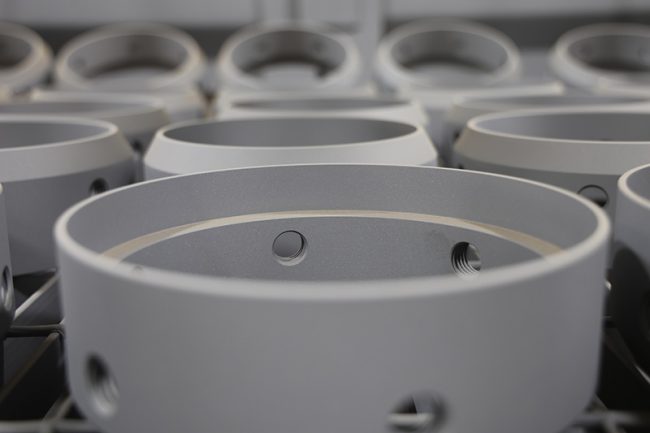BLASTING SERVICES
BLASTING SERVICES
Blasting is a method we use when a surface has to be stripped down, cleaned, or made ready so other coatings or treatments can hold on better. It also comes in when rust, scale, or an old finish has to be taken off right to bare metal. Instead of chemicals, we run abrasive media at high speed.
This work can be done on steel, aluminum, stainless, and other alloys. It can be used on parts that are small or big, simple or with many corners. Blasting sets up what comes after. Without it, coatings don’t adhere properly, and rust form again sooner.
What Blasting Can Do
Blasting can do more than one thing depending on the part and what is needed.
The points below show the results when the right abrasive, pressure, and method are used.
Surface Cleaning
Takes off rust, mill scale, paint, or dirt before more treatment. This leaves a bare and uniform surface so nothing blocks the next step.
Surface Profiling
Makes a texture on the metal that lets coatings like phosphate, spray, or paint stick better. The profile depth is chosen based on what finish or treatment comes after.
Precision Control
Pressure, angle, and abrasive type are set to match the material and its thickness. The operator adjusts so soft alloys don’t get cut too deep and hard alloys still get a sharp, clean cut.
Flexibility
Works on complex shapes, inside passages, or delicate spots by using the right nozzle size and blasting method.
This step is not only for cleaning, but also to give a steady base for the treatments that follow.
How It Works
The blasting steps follow a clear order, starting with part check and ending with a clean piece ready for the next job. Each step is set up to control the finish and avoid damage.
- Inspection: The part is looked at for condition, type of alloy, and masking requirements per drawings.
- Media Selection: Grit, bead, or shot is used based on specification. Each one makes a different profile. For example, glass bead gives a softer satin look, while steel grit cuts hard for removing heavy rust.
- Preparation: The part is placed in the blast chamber or cabinet. Masking is put on if some areas cannot be blasted. Sometimes fixtures are used to hold the piece steady.
- Blasting Operation: Abrasive particles are sent by compressed air or wheel. The operator sets distance, angle, and speed to get the finish that is needed. The blasting continues until all scale or coating is gone and the right profile is made.
- Final Cleaning: Loose abrasive and dust are removed so the part is ready for coating or checking. This may be done with air, brushing, or washing based on the job.

We use several kinds of abrasive media, each chosen for what the job calls for. The two main types we rely on most are:
Glass Bead No.8 & No.10
Gives a bright, satin-like finish without cutting into the base metal. Often used for cleaning, finishing, peening, and deburring in one step. The bead size range (US Mesh 70-100) keeps results consistent and repeatable.
Aluminum Oxide 220
A hard, angular media used for cutting through rust, scale, or coatings. It works on the toughest metals and can be reused many times because of its durability.
These media are picked because they produce clean results fast, leave no unwanted residues, and make the surface ready for coating or bonding right away.
FAQs – Blasting
What types of abrasive media are used?
Choices often include aluminum oxide, steel shot, glass bead, or garnet. Each performs at a different rate and produces a different finish.
Will blasting damage the part?
If it is done right, no. The operator sets the pressure and media to fit the hardness of the part so the structure does not get harmed.
Is blasting always required before coating?
Not every time, but in most cases, it is recommended because it gives better adhesion and longer life to the coating.
How long does a blasting job take?
It depends on the size of the part, type of buildup to be removed, and the media being used. Small parts with light rust can be done quickly, while large components with heavy scale can take much longer.
Does Nitretex reuse blasting media?
No, Nitretex does not recycle blast media. This is disposed of properly in accordance with manufacturer recommendations
Related Services
Blasting is often the first stage before other treatments. The services listed here connect directly with blasting, since each of them benefits from a clean and profiled surface.
Salt Bath Nitriding (QPQ process)
Hardens and improves wear resistance of steel parts through ferritic nitrocarburizing followed by quench, polish, and quench finishing.
Learn more >
Phosphate Conversion Coating
Prepares surfaces with a phosphate layer that adds corrosion resistance and improves coating adhesion.
Learn more >
Spray Coatings
Applies protective or functional coatings using thermal, ceramic, or metallic sprays to extend part service life.
Learn more >
INDUSTRIES WE SERVE
Nitretex specializes in delivering advanced surface treatment services – including Liquid Ferritic Nitrocarburizing (Salt Bath Nitriding/QPQ), spray coatings, phosphate conversion, and blasting – to a variety of industries worldwide.